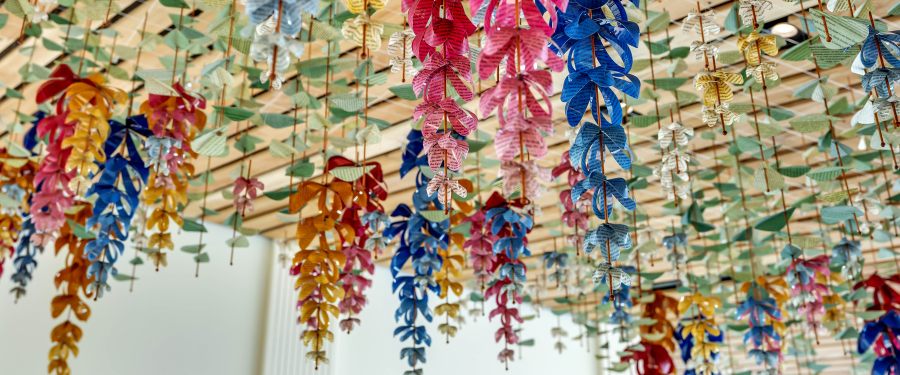A Garden of Language, Rooted in Community
Suspended above the Children’s Reading Room at Woodland Community Library, Phonic Bloom is a one-of-a-kind sculpture created by Portland-based art studio Superfab. The artwork transforms the building blocks of human speech into a hanging garden made of recycled book pages and natural dyes—each petal and reed representing the many ways people speak and connect across cultures and generations.
The Language Within
At its core, Phonic Bloom explores the sounds that connect us. With guidance from linguist Janet Tom Cowal of Portland State University, the artists used the International Phonetic Alphabet (IPA) to map out the sounds used in three major languages spoken in the Woodland area.
How it Works
Phonemes (say: FOE-neems) are the tiny sounds that make up words—like the /b/ in “bee” or the /sh/ in “shoe.” In Phonic Bloom, each flower represents one of these sounds. The artists used this idea to turn speech into a physical, visual experience.
The Colors
The color of each flower was inspired by native plants in Southwest Washington and then assigned to one of the three languages:
Blue tones: Cowlitz Salish
Yellow and orange tones: Spanish
Red tones: English

Some flowers blend colors to show sounds shared by more than one language. White flowers represent sounds used in other world languages. Reeds mark spots where no sound is used in any of the three.
The Chart
This chart shows the speech sounds used in Cowlitz Salish, Spanish, and English. It helped the artists plan the sculpture—deciding where to place each flower and how to color it based on the language it represents (see above for color key).
Each flower shape = one sound
Blended colors show shared sounds between languages
White flowers show sounds used in other world languages
Green leaves show sounds not used in any of the three
The sounds are also grouped by how and where they are made in the mouth—like with the lips, tongue, or throat. This helped the team turn the invisible parts of language into something you can see and explore.

Together, the chart and sculpture invite us to look at language in a whole new way.
A Global Perspective, Rooted in Woodland
Phonic Bloom helps us see language not just as words we say, but as shapes, colors, and connections. It celebrates the rich mix of voices that shape our region—and reminds us that:
Language is cultural – it carries stories and traditions
Language is learned – we gain it through listening and practice
Language is shared – it brings us together

With Special Thanks to Washington State University Vancouver (WSUV)
The Phonic Bloom app, website, and digital materials were created by Fall 2024 graduates of the Digital Technology & Culture program at Washington State University Vancouver. Working in four student teams—Experience, Web, Social Media, and Design—they built the project as part of their senior capstone.
Their work was completed voluntarily and without pay, as a way to give back to the community while building real-world skills.
Contributors include:
Mailei Brodniak, James Lesperance, Andrew Higgins, Courtney Minden, Caleb Stenberg, Andrew Truax, Zoee Lodge, Andrei Juego, Ryan Toedtli, Aaron Shannon, Cameron Dan, Austin Melo, Jenn Nguyen, Cuong Nguyen, Bea Calces, Rich Te, Trystahn Turner, and Evan Leyden.
Together, they contributed over 600 hours, writing more than 2,000 lines of code, crafting 26 animations, and modeling 15 custom 3D assets. Their work helps bring the sculpture to life for kids, families, and visitors of all ages.
Learn more about their work on the student website.
Video Playthrough of the Phonic Bloom Augmented Reality App
This short video shows how the Phonic Bloom augmented reality app works. Created by the WSUV student team, the app helps families explore the sculpture in a fun, interactive way—right from the tablets at Woodland Community Library.

